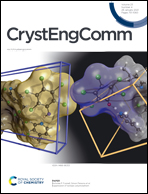Tuning the coordination behavior of an unexplored asymmetric multidentate ligand for developing diverse heterometallic architectures with luminescent and magnetic properties†
Abstract
Recently, by tuning the coordination behavior of a new asymmetric multidentate ligand, H3L, containing two nitrogen and six oxygen donors by both metal centres and anions, H3L = 1-(2-hydroxy-3-methoxy-benzamido)-2-(2-hydroxy-3-methoxy-benzylideneamino)-2-hydroxy propane, three types of heterometallic compounds with the chemical composition of [Zn8Ln2L2(OH)4(OAc)12]·xCH3OH·yCH3CN·zH2O (Zn8Ln2, where Ln = Nd, Tb, Dy and Er), [Ni3Tb2(HL)2(OH)4(OAc)6]·3CH3CN·H2O (Ni3Tb2), and [Ni2Tb2(HL)2(OAc)4(NO3)2(H2O)2]·4CH3CN·3H2O (Ni2Tb2) were developed. Structural analysis revealed that four ellipsoidal decanuclear ZnII–LnIII clusters resulted from the assembly of H3L with Zn(OAc)2·2H2O and Ln(OAc)3·6H2O. Replacement of Zn(OAc)2·2H2O with Ni(OAc)2·4H2O rendered a butterfly pentanuclear NiII–LnIII cluster, and upon further using Tb(NO3)3·6H2O to replace Tb(OAc)3·6H2O, a tetranuclear NiII–LnIII metallocycle was obtained. The luminescence studies on these compounds indicated that the ZnII-containing chromophore is a good antenna for sensitizing the characteristic emission of Ln3+ effectively from the visible to near-infrared region as a result of its energy match, perfect shielding and less concentration quenching compared to its NiII analogues, where the d → d transitions characteristic of Ni2+ were observed in the excitation spectra when irradiated. Notably, weak emission bands characteristic of Tb3+ were observed in the spectrum of Ni2Tb2 but not in that of Ni3Tb2 when excited by the d→d transition, which may be attributed to the difference in crystal field. Furthermore, the magnetic susceptibility studies indicate that the magnetic exchange for the TbIII ions in Zn8Tb2, Ni3Tb2 and Ni2Tb2 is ferromagnetic, whereas that for the DyIII ions in Zn8Dy2 is antiferromagnetic. Our results are of great significance for the rational design and synthesis of novel heterometallic supramolecular structures with interesting luminescence and magnetic properties.

- This article is part of the themed collection: Crystal Growth


 Please wait while we load your content...
Please wait while we load your content...